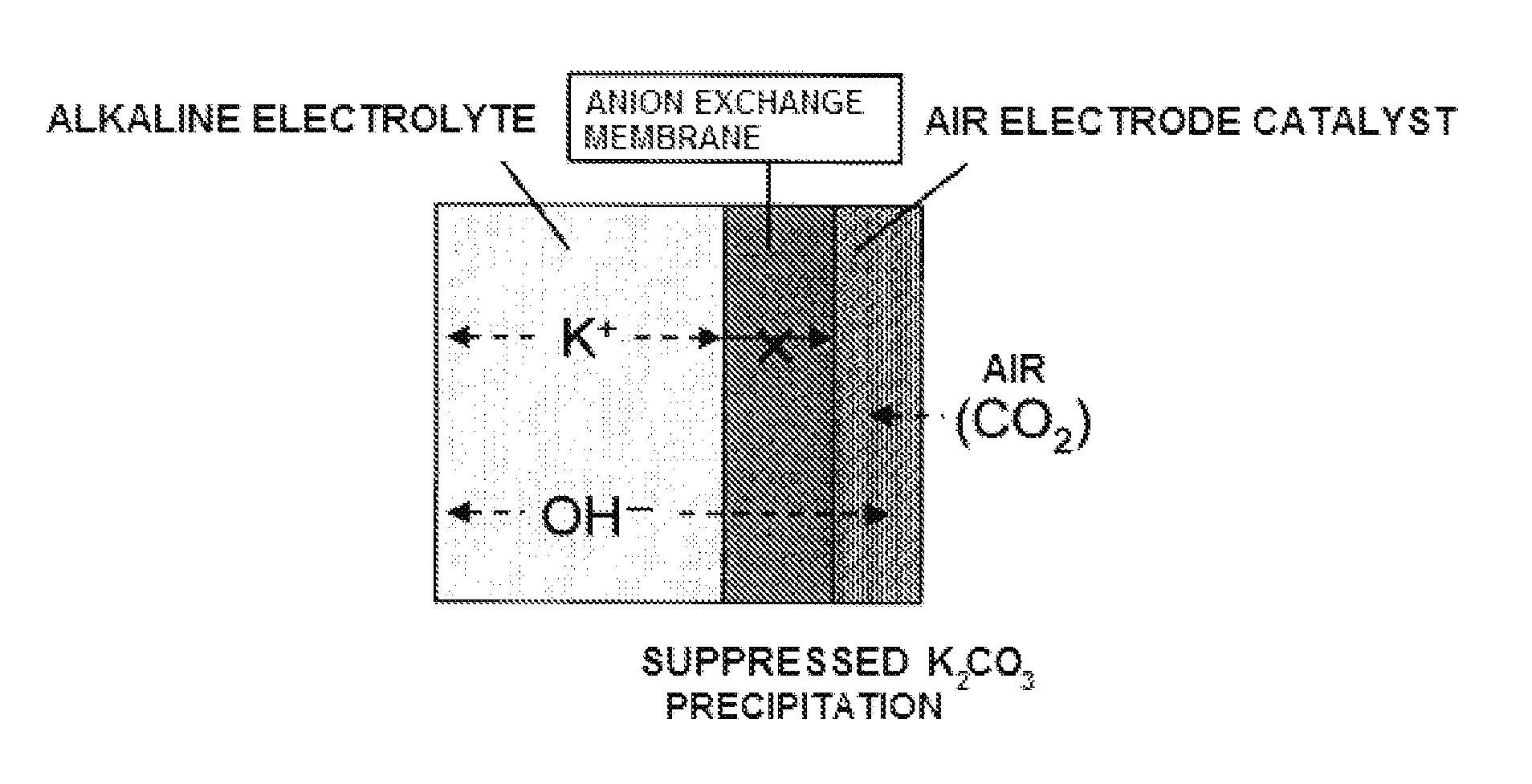Air electrode
a technology of air electrode and positive electrode, which is applied in the direction of fuel and primary cells, cell components, electrochemical generators, etc., can solve the problems of reducing the performance of fuel cells, air cannot be supplied to the positive electrode side, and alkaline fuel cells have not been made available for consumer applications, etc., to achieve excellent activity and avoid leakage of aqueous alkaline solution
- Summary
- Abstract
- Description
- Claims
- Application Information
AI Technical Summary
Benefits of technology
Problems solved by technology
Method used
Image
Examples
example 1
[0080]Platinum black was used as an air electrode catalyst. The platinum black was mixed with a polytetrafluoroethylene dispersion liquid having a concentration of 60 wt % and ethanol such that the ratio (weight ratio) of platinum black:polytetrafluoroethylene dispersion liquid:ethanol=5:1:1, thus obtaining a catalyst ink. The catalyst ink was applied onto a carbon cloth such that the amount of deposited platinum was 3 mg / cm2, and then dried by heating, thus obtaining an air electrode catalyst layer.
[0081]As the anion exchange membrane, a 27 μm-thick hydrocarbon membrane having an ion exchange capacity of 1.4 mmol / g and containing a quaternary ammonium group as an ion exchange group was used. The above-described air electrode catalyst layer was hot-pressed onto one side of the membrane and integrated therewith.
[0082]Using the thus-obtained air electrode, an H-shaped cell, shown in a schematic view in FIG. 2, was prepared according to the following method, and an evaluation test on t...
example 2
[0089]Platinum black that was treated with polytetrafluoroethylene to give water-repellency was used as an air electrode catalyst. This platinum black catalyst was mixed with a 5 wt % solution of anion exchange resin (hydrocarbon-based resin with an ion exchange capacity of 2 mmol / g, which contains a quaternary ammonium group as an ion exchange group) and ethanol such that the ratio (weight ratio) of platinum black:anion exchange resin solution:ethanol=1:2.2:2, thus obtaining a catalyst ink. The catalyst ink was formed into a thin membrane to prepare an air electrode catalyst layer.
[0090]As the anion exchange membrane, a 27 μm-thick hydrocarbon membrane having an ion exchange capacity of 1.4 mmol / g and containing a quaternary ammonium group as an ion exchange group was used. The air electrode catalyst layer obtained according to the above method was hot-pressed onto one side of the membrane, and integrated therewith. The amount of platinum catalyst was 3 mg / cm2, the anion exchange r...
example 3
[0095]An air electrode integrated with the anion exchange membrane was prepared by the same method as in Example 1. This air electrode was inserted into an H-shaped cell shown in FIG. 2, and the oxygen reduction property in the air electrode was evaluated by three-electrode measurements in the same manner as in Example 1.
[0096]After measuring the initial value of the oxygen reduction current in the air electrode, carbon dioxide was supplied to the air electrode catalyst layer side at a flow rate of 100 mL / min for one hour. Then, the air electrode catalyst layer side was again open to the atmosphere, and the oxygen reduction current was measured. This operation was repeated four times, and carbon dioxide was thereby supplied for a total of four hours. Then, the influence of carbon dioxide on the oxygen reduction property was observed.
[0097]Table 3 shows how the ratio (it / i0×100(%)) between the initial value (i0) of the oxygen reduction current at a potential of 0.6 V versus RHE and t...
PUM
 Login to View More
Login to View More Abstract
Description
Claims
Application Information
 Login to View More
Login to View More - R&D
- Intellectual Property
- Life Sciences
- Materials
- Tech Scout
- Unparalleled Data Quality
- Higher Quality Content
- 60% Fewer Hallucinations
Browse by: Latest US Patents, China's latest patents, Technical Efficacy Thesaurus, Application Domain, Technology Topic, Popular Technical Reports.
© 2025 PatSnap. All rights reserved.Legal|Privacy policy|Modern Slavery Act Transparency Statement|Sitemap|About US| Contact US: help@patsnap.com


